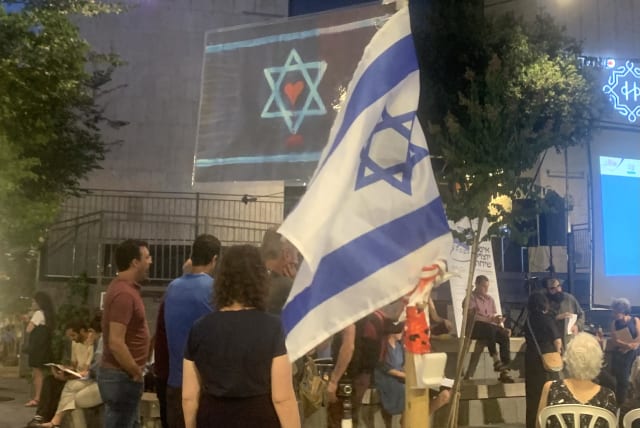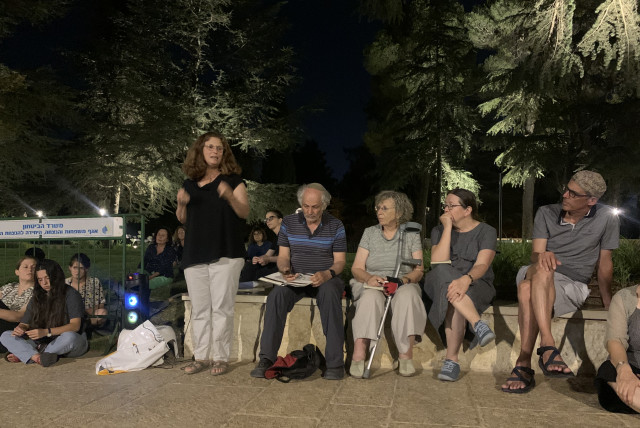Lamentations at Rabin’s tomb link Tisha Be’av to modern tragedies

A young man was playing a somber tune on a piano as dozens of people waited for the chanting of lamentations to start.
The nighttime silence that enveloped the Mount Herzl Military Cemetery was broken only by the mournful chanting of the Book of Laminations around the grave of slain prime minister Yitzhak Rabin.
Dozens of worshipers sat on the ground or on the low stone walls of the walkway around his grave, in what has become an annual tradition to link his assassination in 1995 with the senseless hatred among Jews that contributed to the destruction of the Second Temple some 2,000 years ago.
The fast day of Tisha Be’av, which runs from Wednesday evening to sundown Thursday, had a political undertone this year, occurring just after the Knesset approved the first bill of the government’s controversial judicial reform campaign, which brought hundreds of thousands of protesters to the streets. on the issue of antagonistic divisiveness and the fragility of national unity.
Supporters argue that the Reasonableness Law limiting the Supreme Court’s power of judicial review is needed to preserve Israeli democracy, while its opponents believe it will transform the country into a dictatorship.
At Rabin’s grave, Michal Muszkat Barkan, a professor of Jewish education at Hebrew Union College, addressed the crowd. “When I was reading the scrolls [Book of Lamentations] I was moved by the graphic descriptions of the physical pain, the disaster, the catastrophe, the bodies, the relationships. In every light, the scroll really did not save us from any image of pain,” she said.
But she quickly changed her focus from past to current events: “This experience is like a bad movie. This experience, it hurts in your body to feel the petitions, the leaps in the direction of breaking democracy,” Barkan stated.
The fixed lighting around the grave site was not strong enough for many to follow the reading, so worshipers read from the light of their smartphones or small flashlights to illuminate the texts they held in their hands.
There was camaraderie in the air, with attendees greeting each other and chatting. Both men and women read the lamentations, so when a reader’s phone stopped working, preventing her or him from continuing the passage, neighbors rushed to share their light.
The event this year was sponsored by four NGOs: Tag Meir (United Against Racism), Rabbis for Human Rights, Shared Home Jerusalem, and Oz Hashalom.
Ram Kaplan, an architect who attended the reading, said he tried every single day to protest against the government’s judicial overhaul plan.
“Everything is very fragile,” both then and now, he said. “Society can be very normal. You have a prime minister. The next day you don’t have anything.”
“A prime minister was assassinated in Israel because of his new approach to finding peace, and eventually we ended up commemorating his memory,” said Kaplan. “You can feel how fragile we are… today in Israeli society – very close to the edge of destruction of the Third Temple, which is modern Israel,” he added.
“What is the glue, then?” Kaplan asked, skeptical about what’s holding Israeli society together. He expressed worry about the threat of polarization and how groups across the religious spectrum can remain as one nation in the future.
Aside from the Second Temple, the Tisha Be’av fast has historic links to periods of panic and disaster, such as the Jews’ expulsions from England, France, and Spain, and also the Holocaust.
Political anxiety is thick in the air
This year, political anxiety hung thick in the air. The danger posed by extremism was a recurring theme at a number of Tisha Be’av events, including one held Wednesday in downtown Jerusalem’s Zion Square at 7:30 p.m. as the sun set.
A young man was playing a somber tune on a piano as dozens of people waited for the chanting of lamentations to start.
An elderly woman sat on an encircling bench holding an Israeli flag with an image of a bleeding heart. Dina, who asked that we not use her last name, works with children. She worries about what the future holds.
Ori Banki, whose 16-year-old daughter Shira, was murdered during the Jerusalem Pride Parade in 2015 near Tisha Be’av, spoke at Zion Square.
“Why are we here? We are here because if we are not here, only the extremists will be here, and their loud voices will be heard,” he told the crowd.
“I’m here to tell you that compromise is power, and we need to meet in the middle, most of the people are people who prefer the middle way.”
Jerusalem Post Store
`; document.getElementById("linkPremium").innerHTML = cont; var divWithLink = document.getElementById("premium-link"); if (divWithLink !== null && divWithLink !== 'undefined') { divWithLink.style.border = "solid 1px #cb0f3e"; divWithLink.style.textAlign = "center"; divWithLink.style.marginBottom = "15px"; divWithLink.style.marginTop = "15px"; divWithLink.style.width = "100%"; divWithLink.style.backgroundColor = "#122952"; divWithLink.style.color = "#ffffff"; divWithLink.style.lineHeight = "1.5"; } } (function (v, i) { });

